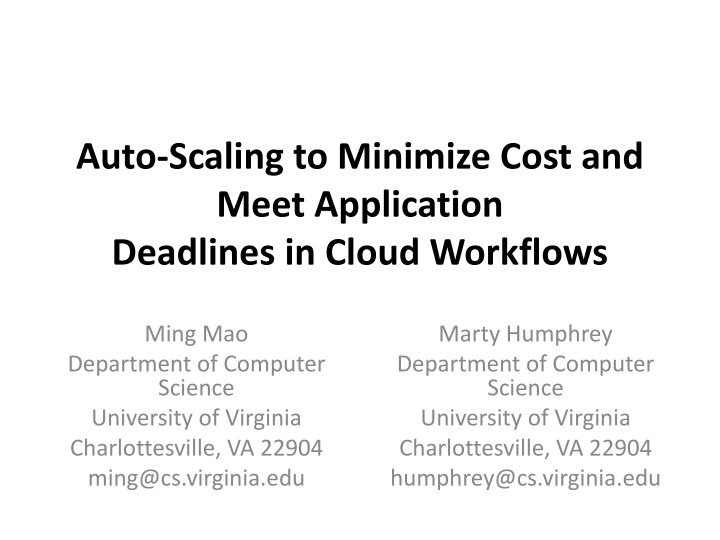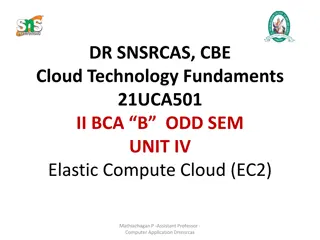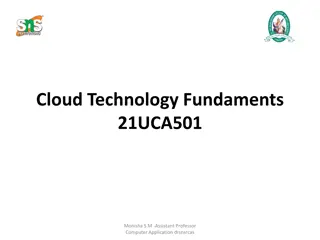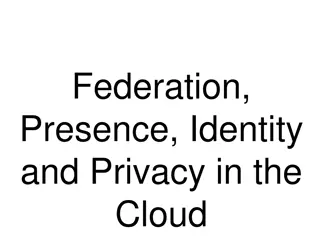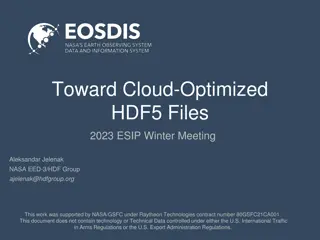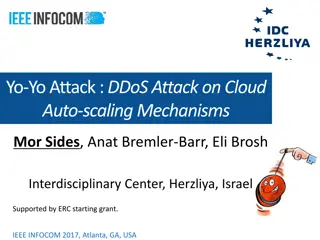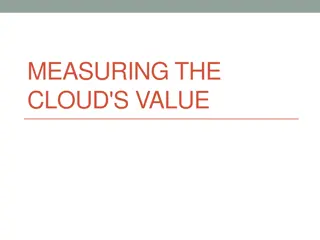Auto-Scaling to Minimize Cost and Meet Application Deadlines in Cloud Workflows
This paper delves into a novel auto-scaling framework that aims to balance performance and cost, ensuring jobs finish before deadlines in cloud applications. It offers various computing resource options, potentially saving costs compared to conventional mechanisms. Assumptions are made regarding cloud application roles, job structures, and resource pricing.
Download Presentation

Please find below an Image/Link to download the presentation.
The content on the website is provided AS IS for your information and personal use only. It may not be sold, licensed, or shared on other websites without obtaining consent from the author.If you encounter any issues during the download, it is possible that the publisher has removed the file from their server.
You are allowed to download the files provided on this website for personal or commercial use, subject to the condition that they are used lawfully. All files are the property of their respective owners.
The content on the website is provided AS IS for your information and personal use only. It may not be sold, licensed, or shared on other websites without obtaining consent from the author.
E N D
Presentation Transcript
Auto-Scaling to Minimize Cost and Meet Application Deadlines in Cloud Workflows Ming Mao Marty Humphrey Department of Computer Science University of Virginia Charlottesville, VA 22904 humphrey@cs.virginia.edu Department of Computer Science University of Virginia Charlottesville, VA 22904 ming@cs.virginia.edu
Introduction Goals that auto-scaling framework should achieve: - balance performance and cost - deliver at least the same level of performance as existing enterprise IT infrastructure - offer different options for computing resources - notice the considerations of real cloud deployments
Introduction Current mechanisms: - schedule-based e.g. Run 10 instances between 8AM to 6PM each day and 2 instances all the other time - rule-based e.g. Add 2 instances when average CPU utilization is above 70% for 5 minutes
Introduction This paper explores a more general application model Goal: to ensure that all jobs finish before their respective deadlines - deadlines are not hard deadlines Consider both job-level and global-level cost-efficiency The approach can save 9.8%-40.4% cost compare to other mechanisms
Problem Formalization Assumptions four roles: - cloud application owner - cloud application users - cloud application itself - cloud resources
Problem Formalization Assumptions (Cloud Application, Job & Task) a cloud application consists of several service units a job consists of sub tasks (simply referred to as taks) all jobs are submitted into the entry unit jobs can be categorized into different classes service units can be classified as compute-intensive, I/O- intensive, or neither
Problem Formalization Assumptions (Cloud resources & pricing) cloud provider offers several types of VMs VM instances are priced by hour application owner can estimate task processing times on different types of VMs cloud instances can be acquired at any time, but there are instance acquisition lags do not consider jobs with theoretically impossible deadlines
Solution first calculate number of VMs needed schedule tasks on each VM using Earliest Deadline First (EDF) algorithm also pre-analyze job classes for potential task bundling and deadline re-assignment
Solution Preprocessing Step 1 Task Bundling Step 2 Deadline Assignment Dynamic scaling-consolidation-scheduling Step 3 Scaling Step 4 Instance Consolidation Step 5 Dynamic Scheduling
Solution Step 1 Task Bundling - treat adjacent tasks that prefer the same instance type as one task and force them to run on the same instance
Solution Step 2 Deadline Assignment - deadlines are associated with jobs, not tasks - Use deadline assignment in a DAG [16], assign individual deadlines to tasks proportionally based the processing time on their most cost-efficient machines - If such assignment cannot finish all jobs in time, further use a heuristic introduced by [17] [16] J. Yu, R. Buyya and C. Tham. 2005. A Cost-based Scheduling of Scientific Workflow Applications on Utility Grids. In Proceedings of the First IEEE International Conference on e-Science and Grid Computing. Melbourne, Australia, Dec. 2005, pp. 140-147. [17] R. Sakellariou and H. Zhao. 2005. Scheduling Workflows with Budget Constraints. Integrated Research in Grid Computing. CoreGrid series, Springer-Verlag, 2005.
Solution Step 2 Deadline Assignment - deadlines are associated with jobs, not tasks - Use deadline assignment in a DAG [16], assign individual deadlines to tasks proportionally based the processing time on their most cost-efficient machines - If such assignment cannot finish all jobs in time, further use a heuristic introduced by [17] [16] J. Yu, R. Buyya and C. Tham. 2005. A Cost-based Scheduling of Scientific Workflow Applications on Utility Grids. In Proceedings of the First IEEE International Conference on e-Science and Grid Computing. Melbourne, Australia, Dec. 2005, pp. 140-147. [17] R. Sakellariou and H. Zhao. 2005. Scheduling Workflows with Budget Constraints. Integrated Research in Grid Computing. CoreGrid series, Springer-Verlag, 2005.
Solution Step 2 Deadline Assignment
Solution Step 3 Scaling - define load vector (LV) for each task - after deadline assignment, an execution interval [T0, T1] is scheduled for each task, and we know its running time on VMmis tm=> LV is defined as [tm/(T1-T0)] - consider instance acquisition lag => [T0, T1] should be [T0+ lagv, T1]
Solution Step 4 Instance Consolidation - avoid partial instance hours to save money
Solution Step 5 Dynamic Scheduling - after deadline assignment and instance consolidation, every task in scheduled to a VM type - use Earliest Deadline First (EDF) algorithm to sort tasks by their deadlines for each VM type - EDF is the optimal scheduling algo. in this case [37][38] [37] Earliest Deadline First Scheduling. http://en.wikipedia.org-/wiki/Earliest_deadline_first_scheduling [38] Earliest Deadline First Scheduling. http://retis.sssup.it-/~lipari/courses/str06/10.edf.pdf
Evaluation [16] J. Yu, R. Buyya and C. Tham. 2005. A Cost-based Scheduling of Scientific Workflow Applications on Utility Grids. In Proceedings of the First IEEE International Conference on e-Science and Grid Computing. Melbourne, Australia, Dec. 2005, pp. 140-147.
Evaluation The prices of these VMs are the same as Amazon EC2
Evaluation Two existing approaches as the baseline: Greedy[16] and GAIN[17] - Greedy: always try to find the cheapest instance among all the live instances - GAIN: starts with the cheapest plan and iteratively improves the plan based on the cost-efficiency rank Compare to our approach denoted as Scaling- Consolidation-Scheduling (SCS) [16] J. Yu, R. Buyya and C. Tham. 2005. A Cost-based Scheduling of Scientific Workflow Applications on Utility Grids. In Proceedings of the First IEEE International Conference on e-Science and Grid Computing. Melbourne, Australia, Dec. 2005, pp. 140-147. [17] R. Sakellariou and H. Zhao. 2005. Scheduling Workflows with Budget Constraints. Integrated Research in Grid Computing. CoreGrid series, Springer-Verlag, 2005.
Evaluation Have randomly generated task execution time on different types of VMs and tried 50 combinations for each workload pattern => test results have shown similar performance For each application and workload pattern, simulate a 72-hour period for each test with four different deadlines 0.5 hour, 1 hour, 1.5 hour and 2 hour Assume instance acquisition lag is 6.5 min
Evaluation When deadline is short, three approaches tend to have similar performance When deadline is longer, SCS generally can save the most cost and Greedy approach performs the worst - the importance of choosing suitable types of VMs Among the four workload patterns, the Growing case has the highest utilization - when workload volume is high enough, task level cost- efficiency could dominate the overall cost
Evaluation For light workload volume, placing tasks on their preferred cost-efficient instances may not always save money
